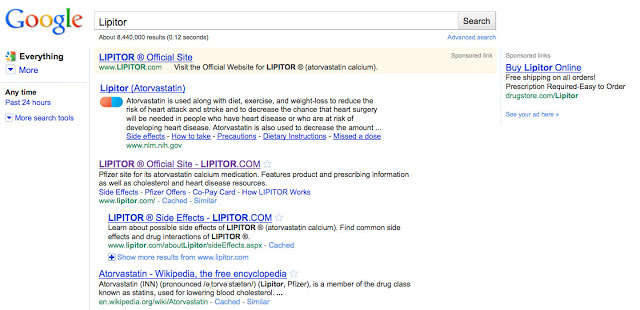Google just launched a NEW Rx drug ad format that includes everything FDA requires that a drug company include in its direct-to-consumer advertising: fair balance, and direct links to side effects, precautions, dietary information, etc. It even includes a logo that identifies it as a special ad sanctioned by a trusted authority! Unfortunately, the new format is only for the National Institutes of Health (NIH) and NOT available to pharmaceutical advertisers.
Below is the result shown on Google after a search on “Lipitor” (click on image for an enlarged view):
 |
| Click on image for an enlarged view. |
At the very top is the typical AdWord that Pfizer paid for. It’s puny and uninformative and does not mention what medical condition Lipitor is approved for. Just below it is the NIH ad, which has all the required and interesting information. It even includes a little colorful pill that draws your attention to the ad and marks it as special. When you click on the NIH ad [actually, it’s not technically an ad, but a natural search result that ALWAYS appears at the top of the natural search results; in that sense it’s an UNPAID ad]. although not a paid ad] you are taken to a page on the NIH site set up especially for atorvastatin, the active ingredient in Lipitor.
This new drug ad format is the latest initiative of Google Health, which last year launched “Health OneBox” that offered easy-to-read details on illnesses and conditions with a single search.
Will these NIH ads compete with drug company’s paid search drug ads, not to mention natural search results? Or can the two work in concert to increase the clickthrough rate on the paid ads?
Either way, Google stands to increase revenue from pharma paid ads. The NIH ads are just another instance of pharma losing share of voice on search engines. They must counteract that with even more advertising. Hopefully, Google’s new ad format specifically designed for pharma (see here) will win FDA approval. That format can compete more effectively with the NIH ads. Not that there’s anything wrong with the NIH ads!








![6 Digital Tools at the Center of Healthcare Digitalization [INFOGRAPHIC]](http://ec2-54-175-84-28.compute-1.amazonaws.com/pharma-mkting.com/wp-content/uploads/2021/04/6DigitalTools_600px-100x70.jpg)




